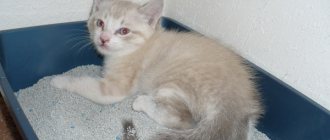To normalize the animal’s psyche, it is necessary to identify the reasons that caused the furry pet’s painful reaction to others. Injections and tablets for a cat to prevent a cat from wanting a cat or herbal sedatives, including drops, sprays for an overly playful pet, have different effects, so the provoking factor is extremely important if it is necessary to prescribe medications. When raising a pet, methods of affection and encouragement are relevant. If you make a cat angry, then after a while a negative reaction will follow.
Aggressive human behavior can make an enraged cat even more angry, aggravate its stressful state and turn it against its owner.
How anxiety manifests itself
Our pets also know how to get nervous and how. Perhaps someone's behavior shocked them and they became angry, or perhaps a minor event caused stress in the cat. The behavior itself will tell you when the cat is nervous. For example, she begins to lick herself often. This may not be caused by parasites, but this action indicates overexertion. The following reactions will definitely tell you that the cat has become very nervous.
- Fear. Looks for a place to hide, or tucks its tail under itself. If a cat is looking for places where it wants to climb so that no one will find it, this is a clear sign of fear. She is afraid of something, for example, the veterinarian or noises, and is looking for a place to calmly wait out what really frightens her. Stress also changes a cat's eating behavior. The cat either eats too much or does not take a bite into his mouth at all.
- Aggression. It is easier to identify, because in a very stressful situation, a cat can even attack those around it. So, this may be a defensive reaction of their cubs. If you see that a cat fluffs its tail, hisses, arches its back, its pupils narrow, its ears are flattened - this is a clear sign of aggression. This condition appears suddenly. Veterinarians explain this behavior by saying that the cat has a stressful situation in its life that it cannot cope with alone.
- Panic. In this case, an external stimulus can send the cat into a panic attack. She begins to scream heart-rendingly, releasing a large amount of saliva. Ears are flattened, pupils are dilated - symptoms of panic are obvious.
- A game. In the game, small pets love to bite and attack people by the arms and legs. You need to know how to calm your kitten down when he gets so angry. If this behavior is caused by play, an educational conversation should be held in order to stop the game, in the case when the cat continues to behave this way.
- Protection of offspring. If a cat has cubs, she will fully defend them. Therefore, she can rush at people if she feels that the offspring are in danger.
- During heat, the cat becomes too nervous.
- Internal illnesses. Get examined by a veterinarian. Perhaps the stress is caused due to internal pain in the cat's body. It is worth checking for diseases by going to the doctor.
- Moving or traveling. Those cats that are used to staying at home and have never gone outside will definitely be scared of this noisy place. They experience enormous stress in a new place and take a very long time to leave it if they feel uncomfortable. Don't cuddle the cat, give it time to get comfortable and just give it support. She will definitely feel that she is not alone, and you will not escape her.
When a cat shows with all its appearance that it is not happy with you, this is not normal. There are some problems that make it difficult for the cat to perceive you as a friend at the moment.
When should you take steps to calm your cat?
The cat wants a cat
Cats are extremely restless during sexual activity. The animal marks its territory and behaves aggressively towards people and other pets. In addition, the cat makes inviting calls, attracting individuals of the opposite sex, and this meowing can last for several hours day and night. To calm a screaming cat and a rabid cat, they can be given special drugs that regulate sexual desire. Another method is more radical, since furry pets will not subsequently have offspring. It consists of castrating a meowing pet in a veterinary clinic, and the cat, so as not to ask the cat, is sterilized.
Protection of offspring
Aggressive behavior in a cat is observed when protecting its offspring, even from people it knows.
Instinctively, mother cats are constantly on guard and ready to protect their young. Therefore, they may have an inadequate reaction even to familiar people and other pets living in the house. After the birth of kittens, it is better not to disturb the family unnecessarily, prepare a safe corner for them in advance, limiting access to it as much as possible for 2-3 weeks, especially children and animals.
Painful condition
The cause of cat aggression is pain. While caressing an animal, a person accidentally touches a painful spot. A child, playing with a furry pet, often hurts by squeezing or pulling the tail. A cat attacks if the owner accidentally steps on its paw. After 12 years of age, cats often develop age-related pathologies, so an elderly pet should be treated with particular care. If a cat cries, meows restlessly or screams for no apparent reason, then there may be health problems and he needs to be shown to a veterinarian, have an ultrasound done, and have blood, feces and urine tested. If there are no pathological abnormalities, the specialist will prescribe sedatives for an overly active animal.
Common pain syndromes that provoke anger in a domestic cat:
- toothache;
- inflammation;
- injury;
- increased body temperature;
- wounds;
- ear pain;
- problems with the gastrointestinal tract.
Fear and panic
If the pet is frightened and driven, it will hiss and attack.
Fright can also make a cat angry. A driven pet without support, except for an attack, finds no other way out. A cat's fear is provoked by any unusual circumstances, for example, the appearance of a stranger or animal, bright light, a sharp sound, or a falling object. The feeling of fear forces an aggressive cat to defend itself, therefore, its actions are unpredictable. External manifestations of fear in an animal:
- hair standing on end;
- piercing gaze;
- pupils dilated;
- tail tucked between legs;
- ears flattened;
- the muzzle is bared;
- hissing and growling sounds.
In case of a powerful outbreak of aggression, experts recommend using water for self-defense. To prevent your cat from fighting, you can try to help him relax by lifting him by the loose skin on his neck, called the scruff, while supporting him under his hind legs, or using a clothespin, placing it on the scruff of the neck behind the ears. You cannot make sudden movements, much less hit the cat, as this will cause even greater hostility. To calm a frightened cat, it is better to leave it alone, providing a safe shelter, for example, a dark corner, where the frantic pet will come to its senses, calm down and feel that nothing threatens it. Then you can try to distract the animal with a treat or favorite toy.
Reaction to affection
Warning signals include flattening of the ears and sudden flicking of the tail.
Typically, the animal, trying to avoid touching, crouches, and before displaying aggression, gives such “warning” signals as meowing, twitching of the skin, sudden movements of the tail, and pinned ears. A cat gets mad from physical contact in the following cases:
- The animal is not used to affection.
- The man touched the animal's sore spot.
- The pet is overexcited and does not want to be petted.
- The cat fell asleep, and then was awakened and frightened by the continued caresses.
Animal psychologists recommend paying attention to your pet’s behavior to avoid an aggressive attack.
No game
Sometimes the cat scratches or bites the owner's legs. Experts explain this by a lack of attention to the animal, because it would like to be played with. This behavior can occur in a cat adopted from the street, surviving alone, and in a small kitten removed from a litter after less than 3 months. To calm an aggressive cat, you should actively play with her, and at the same time accustom your pet to the fact that scratching and biting interrupts fun play. You can try to calm your cat with prey toys that will keep her occupied for a long time. A hearty dinner before bed will help calm down an overly excited cat.
Territory protection
The animal displays aggressive behavior when defending its territory from strangers.
Territorial separation is guaranteed when there are two or more uncastrated animals of the same sex in the house. If the pet is alone, then the hostility is redirected to the person or another pet. For example, a cat sees someone else’s cat outside the window, but is unable to reach it and lay claim to the territory, so it takes out the discomfort it feels on those around it. You can reconcile same-sex individuals living nearby in the following ways:
- Spay or neuter animals at a veterinary clinic.
- Place dishes with food and water in different corners or rooms.
- Buy each a separate tray.
How to identify the cause of anger in a cat
With the help of such reactions, the cat shows with its entire appearance that it should be left alone or helped with something. In order to find out the reason for what is pissing her off, you need to look at the cat’s behavior and assess the environment. It is important to determine what external factor influenced the pet’s irritation. If the irritation is due to internal factors, you know what to do. You need to take your cat to the doctor. Do your own research. So, you have already done half the work and can calm the cat down.
Be sure to monitor your cat's behavior and lifestyle. Perhaps something is bothering her and she needs help.
What to do at home?
Once you have identified the cause of this behavior, there are a number of preventive measures you can take to help your kitty cope with the stress.
It is not necessary to immediately run to the doctor if such behavior is not caused by internal pain. You can figure out the reasons at home and make attempts to help the cat.
Comfortable conditions
You will need:
- Cardboard box or house.
- Separate room for privacy.
You need to leave the cat completely alone. It is also important for her to be alone. This way she will calm down and gain new strength. Create comfortable conditions for her. Provide your cat with shelter. This could be her house or a cardboard box. So, she will climb into a shelter and be able to calm down there and relieve stress.
For cats, boxes are a way of escape and safety. Sitting in it, they are surrounded on four sides by walls, and even with high sides. This makes them feel safe.
Use of drugs
To calm your pet, there are many medications that are aimed at calming a nervous state and are sold as sedatives.
Vet pharmacies sell special sprayers that emit pheromone odors. The animal, sensing a familiar smell, will calm down. For example, there is a product called “Feliway”.
Homeopathic herbal substances that are gentle on the animal. These are available in different forms: spray, tablets, drops. For example, such as “Fitex”.
Chemicals containing herbs. Available in the form of tablets, drops, sprays or injections. For example, “Stop-Stress”, “Xiazin”, “Vetranquill”.
There are hormonal drugs that have a strong effect. They are designed to prevent estrus, but do not stop it completely. Available in the form of tablets, drops and injections. For example, “Sex Barrier”, “Covinan”, “Gestrenol”.
In any case, you should consult your doctor before use. Your cat may not be suitable for chemical or hormonal treatments. It is important to approach this issue delicately and with extreme caution.
Never give your cat valerian. It affects the cat's system like a drug and is addictive.
Water therapy
Cats really hate water, so you can use water to calm your pet. Wet the cat's fur by spraying it with a spray bottle. Or if the cat is not very afraid of the bath, you can put it there and water it from a ladle. So, her attention will switch to her wet fur coat, which now needs to be looked after. For the next hour she will definitely keep herself busy with licking and drying. The problem is solved - the cat is calmed down.
Cats are not fans of water, but this method will clearly cool its ardor and keep it busy for the next couple of hours.
What else can you do?
- Comprehensive examination by a veterinarian. If you notice that your cat is suffering and this is definitely not caused by external factors, you should consult a doctor to see the source of the problem and prescribe treatment.
- Change your diet. A cat's diet can cause stress. It is worth changing the diet, reducing the amount of food or changing the brand. Or reduce portions while increasing the number of feedings.
- Insulation. It is worth not only leaving her alone or giving her a box, but also completely limiting contact with other family members and animals. It is necessary to allocate a separate room in which both food and a tray will be placed. Let her calm down a little in a couple of days and come to her senses. Naturally, it is important to combine this method with another method to cure and help the cat.
- Music. Compositions with a touch of classics will definitely help your cat calm down. You can also try using white noise. Children fall asleep to such sounds, and maybe the cat will be able to calm down.
- Attention. You can try to show attention and affection if the cat is not in a moment of aggression and does not attack you. You can try to caress her, say a lot of good words, stroke her.
Do not self-medicate. So, you definitely won’t help the pet.
When stress is inevitable and planned
If you are planning a visit to a veterinary clinic, transporting an animal (for example, to a dacha), moving, having a child, or other predictable stress factors, you need to start preparing in advance.
Suitable carrier
If the cat needs to leave the house, under no circumstances should you carry it in your arms.
- The pet may become frightened and begin to struggle and scratch wildly.
- The second reason why a carrier is preferable to the owner’s hands or auxiliary devices (basket, sports bag) is that a structure with rigid walls is perceived by the animal as a refuge.
The cat should be comfortable - we are talking about good ventilation and an acceptable temperature. To prevent the pet's paws from slipping on the plastic, and also for warmth, the floor of the carrier is covered with a blanket folded in several layers. A second blanket can be wrapped around the “house” to muffle loud noises (airport, train station, clinic) or for warmth.
In the clinic, after the necessary procedures, the cat is allowed to hide in the carrier on its own, then it understands that it is safe in this house and soon calms down.
Medication support
Calming drops and tablets can be bought without a prescription at a veterinary pharmacy or pet store. Examples of such drugs:
- Kot-Bayun (a combination of many medicinal herbs);
- Fitex (valerian, motherwort, hops, Baikal skullcap);
- Stop-stress (in addition to similar medicinal plants, contains phenibut).
It is important to start giving mild medications designed to calm the animal a few days before the expected stress, otherwise there will be no effect.
Specialized food
If your pet is accustomed to dry food, a special anti-stress diet can be very effective. It could be:
- Royal Canin Calm;
- Hill's c/d Feline Urinary Stress.
Medicinal food begins to be given at least 10 days before the expected event and is used for 2-3 months.
Traditional methods
Folk remedies have a very good effect not only on humans, but also on animals. Therefore, you should turn to this method if you do not want to endanger your cat with chemicals or if it did not help you.
- Chamomile, thyme. Make decoctions from these ingredients and give them to your cat.
- You can spread butter on the cat's face. She will start licking and washing herself, which will occupy herself for a long time.
- Add soda to the milk using the tip of a knife. Let the cat drink and calm down.
- If a cat is in heat, the best option, but not suitable for everyone, is to introduce her to a male cat.
As everyone knows, herbs are good for relaxing and healing the body. They are very useful and contain many beneficial properties.
In case of emergency
There are times when there is no time to prepare decoctions or touch the cat. In emergency cases, you need to act quickly.
Broadcast calm
Keep calm. The cat really feels how nervous its owner is. Because of this, she may begin to experience a lot of stress. If the animal sees that the person is radiating calm, the cat itself will quickly calm down.
Also, calm your cat down with gentle words. Stand or sit away from her and tell her words that she would like to hear. They understand everything, because the sounds of their beloved owner are the most beautiful.
Another way is to try to instill good intentions in your cat using telepathy.
Shift attention
As mentioned earlier, you can use water as a distraction. The cat will definitely keep itself occupied for a long time and will stop feeling stressed.
Try to attract attention to her favorite toy. Play with her, distract her with games.
Play is a good way to keep your cat occupied during aggression. If a cat loves to play, she definitely won’t refuse such an idea.
Morning activity of cats
Early morning awakenings for your pet can have several causes.
· The animal is bored and asks to be entertained
· The cat is hungry and hurries the owner to give out the morning portion of food
· Excess tenderness. Incredible, but true: it is in the morning that cats especially need affection and attention.
You can control your pet’s morning activity by providing him with independent entertainment. For example, give your cat access to a glassed-in balcony, where your pet can watch passers-by on the street.
Coordinate your pet's feeding times so that your cat doesn't feel too hungry in the morning.
Pet the animal only after you have woken up. Don't react to a cat if he asks to be petted at 5 am. The pet must understand: while the owner is sleeping, he cannot be disturbed.
What is not recommended to do
The most important thing that you definitely should not do is hit your pet. The cat is already angry and in a state of increased nervousness. Beating will not help education in any way, but will only cripple the cat inside and out.
Cats quickly show a reflex to our or their actions. Remember Pavlov's dogs. Therefore, do not give your pet food and treats during times of anger and anger. This way she will develop a reflex that when she is angry, she is given food.
If the behavior is caused by heat, but you are not ready for offspring, either have her spayed so that no one suffers, or distract her and be close to her. Just don't disturb her and don't touch her often. Even if she wakes you up in the middle of the night, and you know for sure that it is not caused by pain, do not be fooled by provocations. So, she will understand that she can lift you up with her screams, and you will fulfill all her requests. Each time she will do this more and more persistently.
Cats love to attack people, especially their legs. It could be a game or aggression. You should not give a reason to do this and immediately limit her in such actions.
Growing up and physiology of a cat
The beginning of a cat's heat does not mean that her body is ready for motherhood. In some individuals, estrus occurs very early, even before six months of age, while in others, maturation occurs much later - after 10-12 months. On average, the first heat in cats occurs at 7-8 months. You should not rush into mating at this age. The body is not yet strong and not fully formed. It is better to postpone the important moment of motherhood for a couple of months after the first heat.
Readiness for mating in males is constantly observed, the main thing is that the cat is in heat. The possibility of conception in a pet is limited to several days of estrus (on average 5-7 days). The onset of sexual heat for a cat living in an apartment does not depend on the time of year, that is, the need for a male can arise in any month.
In the wild, the peak of cat sexual activity occurs at the end of February - beginning of March. If fertilization has occurred, the cat stops walking. If pregnancy does not occur, the animal may go into heat every two weeks. The timing is individual and does not indicate the health of the pet. Some individuals are overly sexual, while for others it is enough to walk with a cat 2-3 times a year.











